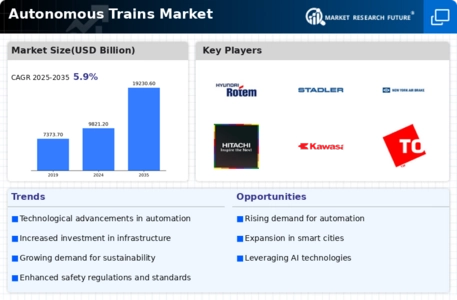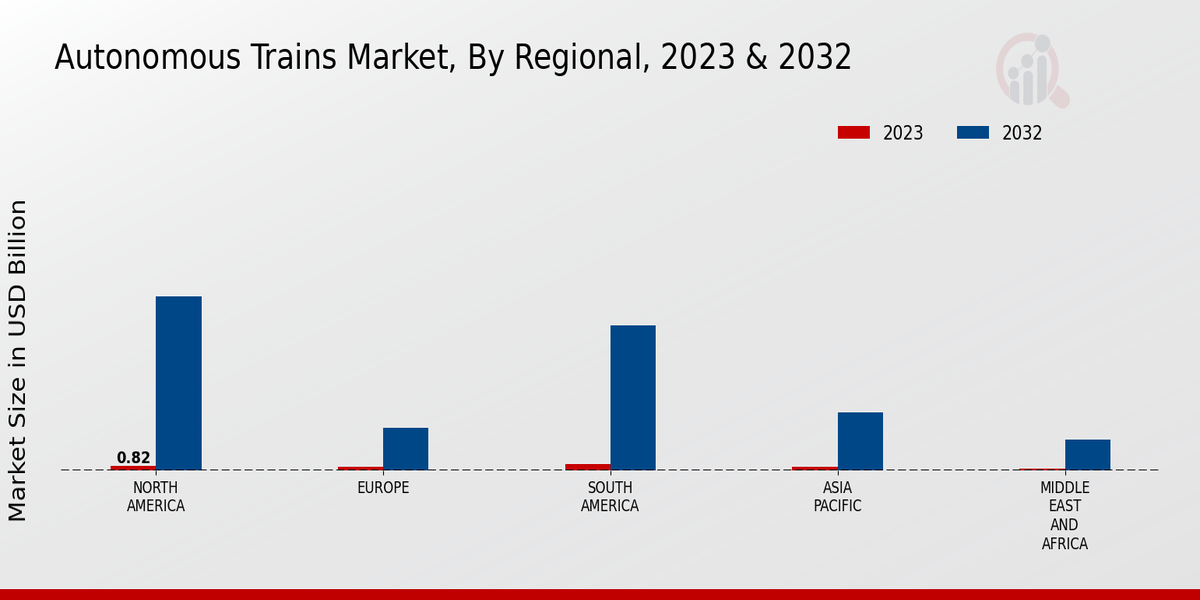Market Growth Projections
The Global Autonomous Trains Market Industry is projected to experience substantial growth over the coming years. With a market value expected to reach 9821.2 USD Billion in 2024 and an anticipated increase to 19230.6 USD Billion by 2035, the industry is poised for significant expansion. The compound annual growth rate of 6.3% from 2025 to 2035 indicates a robust demand for autonomous rail solutions. This growth is likely driven by a combination of technological advancements, government support, and increasing urbanization, suggesting a promising future for the autonomous trains sector.
Technological Advancements
The Global Autonomous Trains Market Industry is propelled by rapid technological advancements in automation and artificial intelligence. Innovations such as advanced sensor systems, machine learning algorithms, and real-time data analytics enhance operational efficiency and safety. For instance, companies are increasingly integrating LiDAR and computer vision technologies to improve navigation and obstacle detection. This technological evolution is expected to contribute to the market's growth, with projections indicating a market value of 9821.2 USD Billion in 2024. As these technologies mature, they are likely to reduce operational costs and improve service reliability, further driving adoption across various regions.
Safety and Efficiency Improvements
Safety and efficiency improvements are paramount in driving the Global Autonomous Trains Market Industry. Autonomous trains are designed to minimize human error, which is a leading cause of accidents in rail transport. By utilizing advanced monitoring systems and automated controls, these trains can operate with enhanced precision and reliability. For instance, the implementation of automated train control systems has demonstrated a reduction in operational delays and accidents. This focus on safety not only boosts public confidence in rail travel but also encourages investment in autonomous technologies, thereby fostering market growth.
Urbanization and Population Growth
Urbanization and population growth are key drivers influencing the Global Autonomous Trains Market Industry. As urban areas expand, the demand for efficient public transportation systems intensifies. Autonomous trains offer a viable solution to address congestion and improve mobility in densely populated cities. For instance, cities like Tokyo and London are exploring autonomous rail solutions to enhance their public transport networks. This trend is expected to contribute to a compound annual growth rate of 6.3% from 2025 to 2035, as urban planners increasingly recognize the potential of autonomous trains to provide sustainable and efficient transit options.
Government Initiatives and Investments
Government initiatives play a pivotal role in the expansion of the Global Autonomous Trains Market Industry. Many countries are investing heavily in rail infrastructure modernization and automation to enhance transportation efficiency and reduce carbon emissions. For example, the European Union has launched several funding programs aimed at promoting smart and sustainable transport solutions. Such initiatives not only provide financial support but also create regulatory frameworks that encourage the adoption of autonomous technologies. As a result, the market is anticipated to grow significantly, with a projected value of 19230.6 USD Billion by 2035, reflecting the increasing commitment of governments to modernize rail systems.
Environmental Concerns and Sustainability
The Global Autonomous Trains Market Industry is increasingly influenced by environmental concerns and the push for sustainable transportation solutions. Autonomous trains, being more energy-efficient than traditional rail systems, contribute to reduced greenhouse gas emissions. This aligns with global sustainability goals, prompting governments and organizations to invest in cleaner transport technologies. For example, initiatives aimed at electrifying rail networks and integrating renewable energy sources are gaining traction. As awareness of climate change grows, the market is likely to see heightened demand for autonomous trains, further solidifying its position as a sustainable alternative in the transportation sector.

















